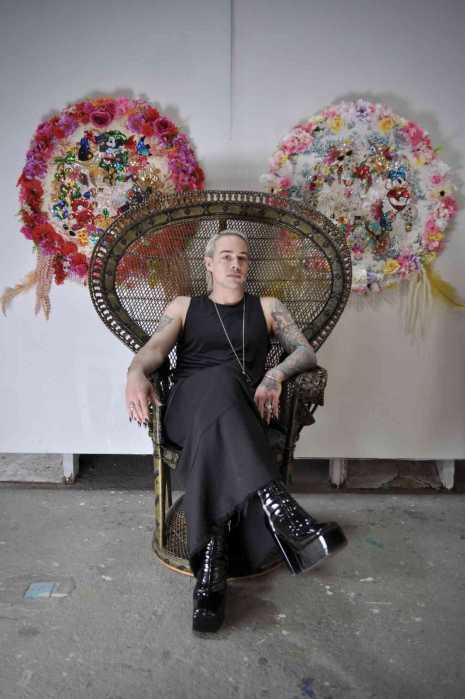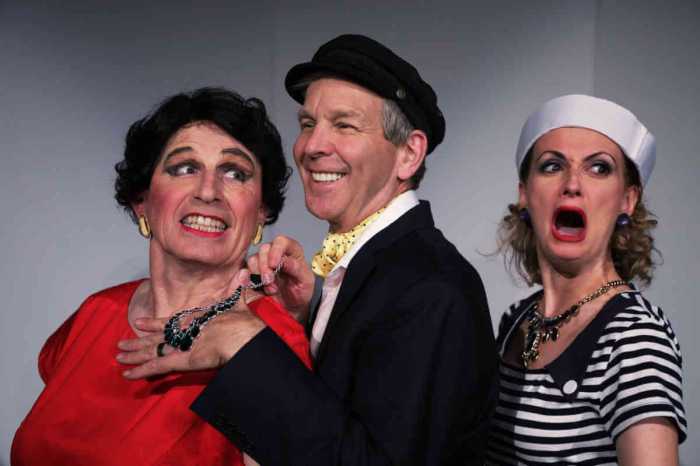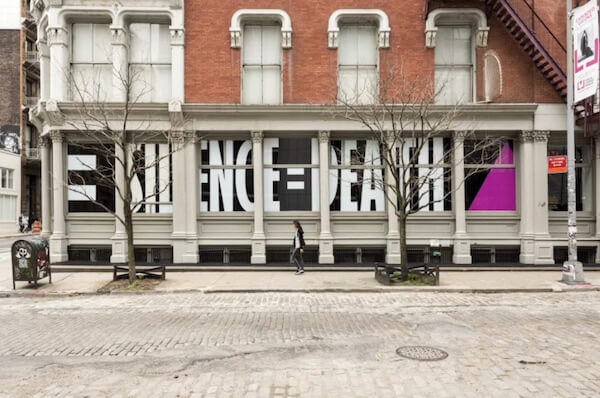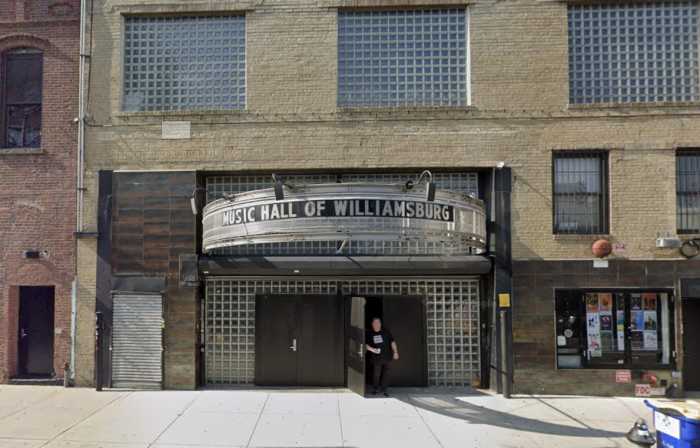9.438 x 18 in.). | LA MAMA LA GALLERIA/ LOAN FROM LESLIE-LOHMAN MUSEUM OF GAY AND LESBIAN ART/ GIFT OF THE INGO SWANN ESTATE ” width=”669″ height=”400″ />
Ingo Swann’s “The Demonstration Showing How It’s Done: Social Comment Series” (collage,
9.438 x 18 in.). | LA MAMA LA GALLERIA/ LOAN FROM LESLIE-LOHMAN MUSEUM OF GAY AND LESBIAN ART/ GIFT OF THE INGO SWANN ESTATE
BY SCOTT STIFFLER | A prolific visionary held in high regard by peers from the realms of art, psychic phenomena, gay erotica, and Cold War counterprogramming, Ingo Swann (1933-2013) blazed a multiplicity of paths remarkable not simply because they are the achievements of a man ahead of his time, but also because he did not regard his abilities as exceptional gifts. We are all capable of tapping the cosmic consciousness, Swann insisted, if properly motivated to learn how.
For Swann, that spark of desire was ignited in a Lower East Side apartment, when a recently acquired pet chinchilla became evasive before each night’s return trip to its cage. If this furry little creature could sense the plan well in advance of the action, then why, Swann wondered, did that same ability elude him?
By the early 1970s, the self-taught artist had secured his legacy as a founding father of “remote viewing” — a phrase he coined to describe the practice of being given coordinates distant from one’s physical body, then describing the location in seven stages of progressively greater detail. Honed while at the Stanford Research Institute, Swann’s abilities led to his employment at various clandestine agencies, where he became a valued member of the US government’s remote viewing program.
“Ingo Swann: A Remote View” chronicles prolific visionary’s rich, outrageous output
Spurred by Soviet efforts to militarize extrasensory perception, the Star Gate project (original name, “Gondola Wish”) ran from 1977 to 1995. In later years, Swann would express regret for his time as a “psychic spy.” But by all accounts, he never disavowed his firmly held belief that a penis — extracted from the pages of a men’s skin magazine — can never be too big when recruited for use as the focal point of a multi-layered collage.
Colorful and compelling and epic as all of this might seem, it merely scratches the surface of tidbits, testimonials, insights, and aesthetic observations shared with a curious and receptive audience at a June 19 panel discussion held in conjunction with the exhibit “Ingo Swann: A Remote View.” The well-informed panelists were every bit as eclectic and probing as the scope of their subject’s output during his 80 years on this particular plane of existence.
To panelist Elly Flippen, Swann was a “cigar-chomping enigma.” Despite having lived with her uncle for a number of years over three separate periods, Flippen couldn’t say for sure if Swann had sustained romantic relationships, or explain with certainty why his decades of artistic output stopped a full 13 years before his death — but she did speak of him with great fondness. A glint in her eye recalled the mischievous humor present in Swann’s most sexually charged visual compositions, such as the ’90s-era collage “The Demonstration Showing How It’s Done: Social Comment Series,” in which a bearded leatherman straddles his male partner, while a phalanx of straightlaced ballroom debutantes witness the act of anal penetration from their background vantage point.
Asked to what extent Swann lived as an out gay man, Flippen recalled, “Well, he dressed as a nun and went to Studio 54” — a jarring, but not necessarily contradictory, detail, when one brings that knowledge to a viewing of “Madre Doloroso.” Evocative on many levels, the 1986 painting conveys Swann’s adoration of the Virgin Mary (arms folded, she looks downward in a state of compassionate contemplation), his merging of the sacred and the cosmic (a cross-shaped constellation), and his concern for the fate of man (an atomic mushroom cloud, just beneath the Virgin’s torso).
An installation view of Ingo Swann’s “Madre Doloroso” (1986, 50 x 42 in.). | LA MAMA LA GALLERIA
That painting, which graces the cover of Swann’s 1996 book, “Great Apparitions of Mary: An Examination of Twenty-Two Supranormal Appearances,” almost didn’t make it into the current exhibit. Panelist Rebecca Alban Hoffberger, founder and director of Baltimore’s American Visionary Art Museum (AVAM), told the story of attempting to secure the painting. “Swann was particularly fond of the work, which he reluctantly sold,” Hoffberger noted. When the buyer passed away (followed by her husband a short time later), “nobody knew where that painting was.” With the search at a standstill, Hoffberger placed a copy of “Great Apparitions of Mary” under her pillow. The next day, the new owner contacted AVAM, expressing his willingness to sell. The asking price was beyond their reach — but Hoffberger kept the work, and Ingo, on her mind. Unbeknownst to her, the owner independently contacted Harrison Tenzer, curator of “A Remote View,” and moderator of the panel. Ultimately, the piece found its way back to Swann’s family, who will gift it to AVAM — where it will join five other paintings by Swann, as well a huge triptych that appears in the museum’s three-story central stairwell.
Hoffberger does not regard this narrative as meaningless serendipity, nor does she view Swann’s art as “just a flight of imagination.” Citing frequent invocation of auras, spirit animals, gender fluidity, and swirling galaxies in his work, Hoffberger asserted that Swann’s organization of subject matter and technical mastery of any given expressive medium are the work of a man who is “tapping into something more” than wishful thinking and whimsy.
Also marveling at the scope of Swann’s self-taught accomplishments was fellow panelist Hunter O’Hanian. As director of Soho’s Leslie-Lohman Museum of Gay and Lesbian Art, O’Hanian described a common occurrence: leading museum tours, where Photoshop-savvy millennials marvel at the discipline and resourcefulness of Swann’s collage work. This was an era, O’Hanian noted, when “cut and paste” meant the use of an X-Acto knife and rubber cement (whose strong fumes, Flippen recalled, left the uncle and niece feeling “really happy” as they toiled in his dark, congested basement studio — where, one surmises, good air circulation was not among the amenities).
O’Hanian asked the audience to rise from their seats and join him to discuss six 8×10 collages, on loan from Leslie-Lohman’s permanent collection (which boasts 200 of those works, along with 16 paintings by Swann). The gallery’s rear alcove was a fitting location; tucked away from the large works of cosmic themes and import, an air conditioner situated mere feet away served to cool down the hot and bothered.
“He was 36 in 1969, the year of Stonewall,” O’Hanian noted, taking those assembled through the gay imagery that Swann had access to when building collages (eight layers deep in some cases) around naked men cut from the pages of gay skin mags like Honcho and Drummer. This technique necessitated other visual elements, such as the background environment, to be taken from art, historical, or decorative publications of the time; chosen not only for the mood they conveyed, but in a manner that complemented how Swann’s dirty magazine denizens were lit — as with “Awaiting Reincarnation and the Ecstasy of Re-Embodiment,” in which a disproportionately small farmer in overalls looks upon a naked young man, who sports a welcoming grin and a throbbing erection.
“Who is he making these for?” O’Hanian wondered. It was one of many unanswered questions that, for all of their scholarship and insider knowledge, the panel was at a loss to fully explain. This seemed a fitting testimony; not so much to Swann’s enigmatic nature, as to what Flippen described as a “compartmentalized” existence in his latter decades, when artists, celebrities, clairvoyants, Manhattan socialites, and students from his remote viewing days were drawn to the building he owned on Bowery and East Fourth Street — the same space where, years before, a chinchilla who preferred not to be caged set his owner on a journey of sexual and spiritual freedom. “From an early age,” Flippen said of her uncle’s extrasensory instincts, “he was taught to suppress it, that it’s evil; like being gay.
INGO SWANN: A REMOTE VIEW | La MaMa La Galleria | 47 Great Jones St., btwn. Bowery & Lafayette St. | Through Jul. 3: Wed.-Sun., 1-7 p.m. | Free admission | Information at lamama.org/lagalleria
Scott Stiffler is the editor of Chelsea Now, a sister publication to Gay City News.




































